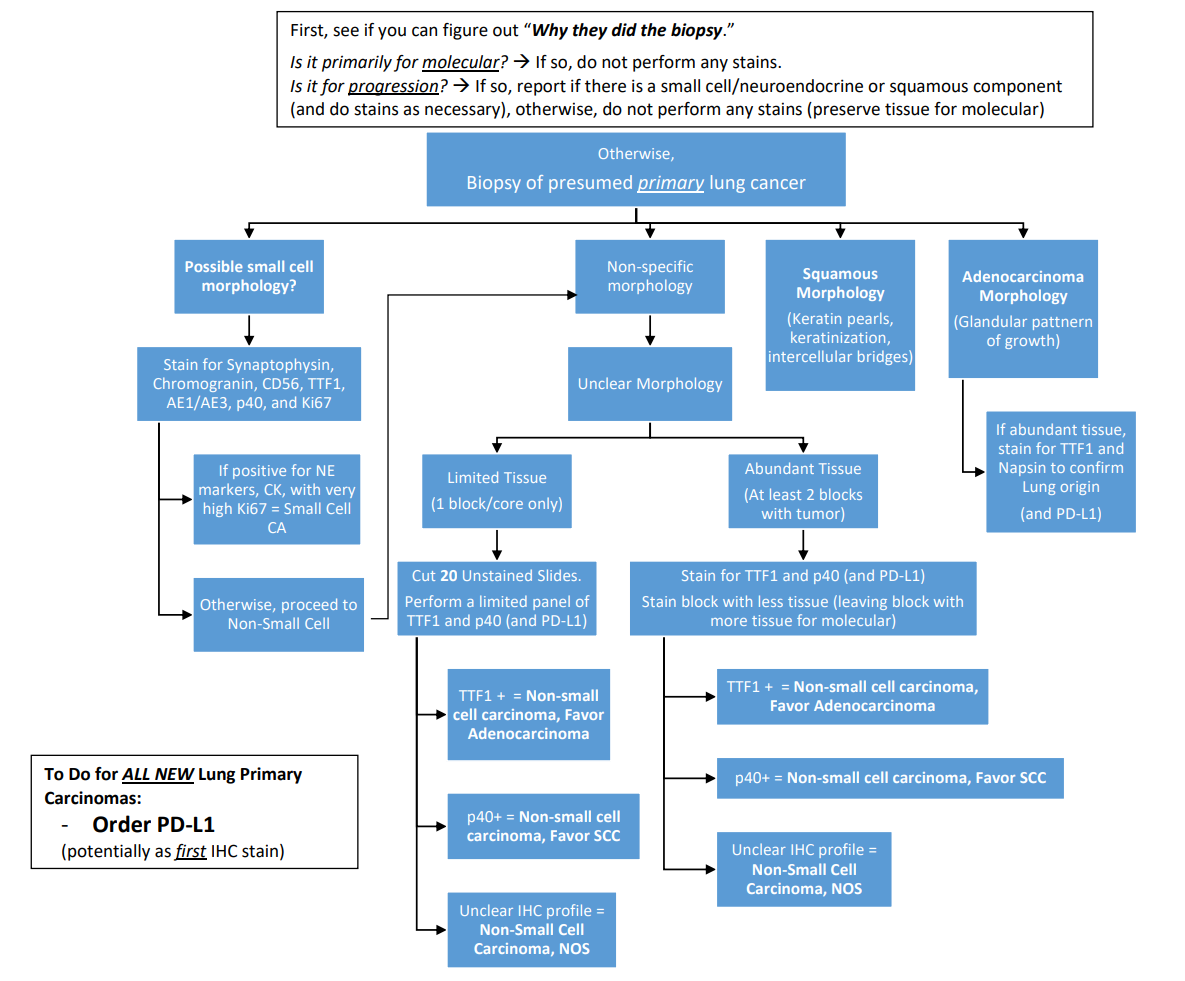
If there is overt evidence of squamous differentiation, such as keratinization, keratin pearls, and/or intracellular bridges:
– Squamous cell carcinoma
If there is evidence of glandular differentiation, such has gland formation or cytoplasmic mucin:
– Adenocarcinoma (see comment)
COMMENT: The biopsy shows an adenocarcinoma with *** growth patterns.
[Fill in the blank with a combination of: Lepidic, Acinar, Papillary, Micropapillary, and/or Solid]
If there is an adenocarcinoma with pure lepidic growth in the biopsy:
– Adenocarcinoma with a lepidic pattern (see comment)
COMMENT: The biopsy shows an adenocarcinoma with exclusively lepidic growth in the biopsy. The differential diagnosis includes adenocarcinoma in situ and the lepidic component of an invasive adenocarcinoma. Clinical and radiographic correlation is recommended.
If there is an adenocarcinoma with unique features:
(Many special types of adenocarcinoma cannot be definitively diagnosed on a small biopsy, so we should just mention that it has “features” of that type)
– Mucinous adenocarcinoma (see comment)
COMMENT: The biopsy shows a proliferation of cells with abundant intracytoplasmic mucin and bland nuclear features consistent with an invasive mucinous adenocarcinoma. This tumor shows predominantly *** growth. While these findings are compatible with lung origin, clinical correlation is necessary to exclude a mucinous metastasis (particularly from the GI tract).
– Adenocarcinoma with colloid features (see comment)
COMMENT: The biopsy shows an adenocarcinoma with abundant extracellular mucin and tumor cells floating in mucin. These findings are diagnostic of adenocarcinoma and are suggestive of a colloid adenocarcinoma. The differential diagnosis also includes a carcinoma with focal colloid differentiation and a mucinous (colloid) carcinoma metastasis. Clinical correlation is recommended.
– Adenocarcinoma with fetal features (see comment)
COMMENT: The biopsy shows an adenocarcinoma with complex proliferation of glands with abundant cytoplasmic clearing, bland, monotonous nuclei, and frequent morule formation. These findings are diagnostic of an adenocarcinoma and are suggestive of a fetal adenocarcinoma, which is supported by Nuclear/cytoplasmic staining with β-catenin. Clinical correlation is recommended.
If there is an adenocarcinoma in the lung that essentially looks like colon cancer and stains like colon cancer
– Adenocarcinoma with enteric features (see comment)
COMMENT: The biopsy shows an adenocarcinoma with abundant dirty necrosis and an immunohistochemical profile that is often seen with enteric/intestinal adenocarcinoma. Clinical correlation is required to exclude a metastasis from the colon/gastrointestinal tract. If a metastasis has been excluded, then these findings could be compatible with a primary lung enteric-type adenocarcinoma.
If a tumor is not clearly squamous morphologically, but the IHC profile supports squamous (e.g., p40 +)
– Non-small cell carcinoma, favor Squamous cell carcinoma (see comment)
COMMENT: The biopsy demonstrates a non-small cell carcinoma without clear keratinization. However, the tumor stains with an immunohistochemical stain for p40, favoring a squamous cell carcinoma. Clinical and radiographic correlation is recommended.
If a tumor is not clearly adenocarcinoma morphologically, but the IHC profile supports adenocarcinoma (e.g., TTF1 +)
– Non-small cell carcinoma, favor Adenocarcinoma (see comment)
COMMENT: The biopsy demonstrates a non-small cell carcinoma without gland formation. However, the tumor stains with an immunohistochemical stain for TTF1, favoring an adenocarcinoma of lung origin. Clinical and radiographic correlation is recommended.
If a tumor is not clearly categorizable as adenocarcinoma or squamous cell carcinoma by IHC and morphology (e.g., TTF1 and p40 -). Consider doing other stains to exclude a metastasis or non-carcinoma, etc…
– Non-small cell carcinoma, Not Otherwise Specified
If a tumor is not clearly morphologically adenocarcinoma or squamous cell carcinoma and tumor is very scant and tissue is anticipated to be needed for additional studies, so additional work-up is forgone
– Non-small cell carcinoma, Not Otherwise Specified (see comment)
COMMENT: The biopsy shows a non-small carcinoma without clear squamous cell carcinoma or adenocarcinoma features morphologically. Given the limited material, additional work up with immunohistochemical stains to further categorize the tumor was not pursued to save as much tissue as possible for other anticipated additional studies. However, they could be performed if requested. Clinical and radiographic correlation is recommended.
Other special scenarios:
– Non-small cell carcinoma with spindle cells (see comment)
– Non-small cell carcinoma with giant cells (see comment)
COMMENT: The biopsy shows a carcinoma with areas of malignant spindle cells [or giant cells]. These findings are suggestive of a spindle cell carcinoma (also known as “sarcomatoid carcinoma” and “pleomorphic carcinoma”).
– Adenocarcinoma and Squamous cell carcinoma (see comment)
COMMENT: The biopsy shows a tumor with areas of both distinct squamous cell carcinoma and adenocarcinoma growth, which is suggestive of “Adenosquamous carcinoma.” This diagnosis can only be made definitively on resection specimens as it is required that both component constitutue >10% of the tumor.
Neuroendocrine Lesions:
– Carcinoid Tumor (Neuroendocrine Tumor, Not Otherwise Specified) (see comment)
COMMENT: The lung biopsy shows a carcinoid tumor. No mitotic figures or necrosis are identified in this limited biopsy, compatible with the diagnosis of “typical” carcinoid tumor. However, given the limited sampling, final classification is deferred. The proliferation index by staining for Ki67 is ***%.
– Small cell carcinoma
Large cell neuroendocrine carcinoma, in many circumstances, cannot be definitively diagnosed on a small biopsy as there must be both morphologic and IHC evidence of NE differentiation.
– Non-small cell carcinoma, possible Large cell neuroendocrine carcinoma (see comment)
COMMENT: The biopsy shows a tumor with a suggestion of trabecular growth with peripheral palisading and large cells with vesicular chromatin and prominent nucleoli and abundant cytoplasm. Immunohistochemical stains demonstrate neuroendocrine differentiation. Together, these findings raise the possibility of large cell neuroendocrine carcinoma.